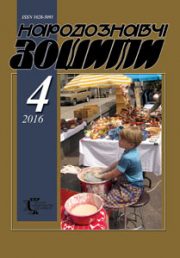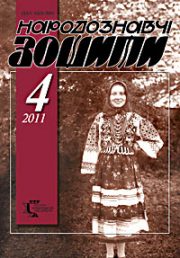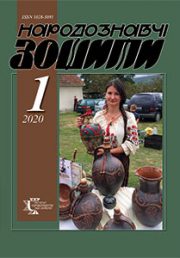The Ethnology Notebooks. 2019, № 3 (147), 591—607
UDK 392.33(477.41/.42)
DOI https://doi.org/10.15407/nz2019.03.591
THE MECHANISMS OF СREATING NEW FAMILY TIES (based on the data from Right-Bank Polissia)
KONDRATIUK Olena
ORCID ID: https://orcid.org/0000-0002-5996-1768
Сandidate of History (Ph. D),
Head of Department of Ethnology
State Scientific Center of Cultural Heritage Protection from Technogenic Catastrophes
21, Vyshgorodskaya st., 04114, Kyiv, Ukraine
Contacts: е-mail: lenvin2007@gmail.com
Abstract. Among Ukrainian rituals of family cycle wedding is significant one. Modern socio-humanitarism gives preference to studying certain circumstances in bordered areas. Therefore, the wedding theme that concerns the mechanisms and principles of creating new family ties in Right-Bank of Polissya is very relevant today. The author’s goal is to analyze the main stages and mechanisms of creation of new kinship ties and to define a role and significance of verbal formulas, item markers and home locuses during this process. The object of the research is a ritual of family cycle, as a component of the folk culture of polischuks. The subject is kinship ties. The methodological basis of this work is objectivity and historicism principles. The methods for comparative and structural-functional analysis were used to process field and archival, ethnographic, folklore and ethno-linguistic material. The source base of the research consists of the author’s field materials and recordings of other scientists of the State Scientific Center of Cultural Heritage Protection from Technogenic Catastrophes in comprehensive historical-ethnographic expeditions on the territory of Polissіa. The basis of the work is the author’s field materials.
The process of creating new kin relations took place stage-by-stage through all wedding ceremony. At first, we fix the presence of two kins presented in several oppositions: own – alien, old — new. The process of establishing new kin relations is presented not only by in-law terms but also by the vocabulary of wedding ceremony, for instance, wood, drunk down, wedded. Exactly they marked brightly the transition of a bridegroom and a bride from the group of unmarried youngsters to the full-righted members of the community. Foremost, fixing of the accepted decision of becoming a kin took place at verbal level, using towards the new relatives, such terms like svat, svakha, diver (brother-in-law), zovytsia (sister-in-law), daughter, son, father, mother. And yet, through implementation of concrete ritual actions in certain locus of the house: a stove, a pokut’ (icon corner) and a threshold.
On each of the stages of a wedding (betrothing, asking in marriage, buying the bride back, connection of candles, distributing round a loaf of bread, meeting of daughter-in-law by mother-in-law, tying up a khustka, equipping a new habitation by a young hostess) there were ritual actions that had for an object to fasten a newly created relation between two families. And the main, after the wedding ceremony was completed, the girl must not only organically come into «alien» locus of her husband, but also find understanding with him and his family.
Keyword: in-laws, wedding, kin relations, kinship terms, Right-bank of Polissia.
Received 11.04.2019
REFERENCES
Sumtsov, M. (1881). On wedding ceremonies, mainly Russian. Kharkov [in Russian].
Vovk, F. (1995). Marriage ritual and ceremonies in Ukraine. Studios from Ukrainian ethnography and anthropology. Kyiv: Art [in Ukrainian].
Zdorovega, N. (1974). Essays on folk wedding ceremonies in Ukraine. Kyiv: Naukova dumka [in Ukrainian].
Borysenko, V. (1988). Wedding customs and ceremonies in Ukraine: Historical-ethnographic research. Kyiv [in Ukrainian].
Borysenko, V. (2012), Women’s wedding ceremonies of the traditional ritual of Ukrainians. National culture of Ukrainians: life cycle of a person (Vol. 3, pp. 161—164). Kyiv: Dulidy [in Ukrainian].
Borysenko, V. (1987). Family customs and rituals. Social, family life and spiritual culture of the population of Polesia (pp. 153—182). Minsk: Nauka y tekhnyka [in Russian].
Nesen, I. (2005). The wedding ritual of Central Polissya: the traditional structure and forms of relic (mid XIX — XX centuries). Kyiv [in Ukrainian].
Nesen, I. (2002). The mythological aspect of space at the wedding of the Сentral Polissya. The Ethnic History of European Nations (vol. 13, pp. 41—46) [in Ukrainian].
Romanyuk, Р. (1983). From the experience of mapping the wedding ceremony of the Right-bank Polesye. Polesye ethnographic collection (pp. 198—205). Moscow: Nauka [in Russian].
Romanyuk, P. (1996). Polis’ke wedding: ritual and vocabulary. Polissya: language, culture, history (pp. 110—113). Kyiv [in Ukrainian].
Archive of the State Scientific Center of Cultural Heritage Protection from Technogenic Catastrophes [in Ukrainian].
Kravchenko, V. (1920). Customs in the village of Zabridi, Zhytomyr district. Ethnographic materials. Zhytomyr [in Ukrainian].
Kravchenko, V. (2009). Collected works and materials from the archival heritage (Vol. 2). Kyiv [in Ukrainian].
Borysenko, V. (2011). This zhytka…: The culture of the Ukrainian people of the Chernobyl Polissya (based on the materials of the ethnographic expedition in 1994). Kyiv [in Ukrainian].
Bilodid, I. K. (Ed.). (1978). Dictionary of the Ukrainian language (Vol. 9). Kyiv [in Ukrainian].
Yefimenko A. (1884). Study of national life (Vol. 1). Moscow [in Russian].
Hrymych, M. (2003). Agreements on the customary right of Ukrainians in the nineteenth and early twentieth centuries. Ethnic history of the peoples of Europe (Vol. 15, pp. 11—18). Kyiv [in Ukrainian].
Chubinsky, P.P. (Ed.) (1872). Proceedings of ethnographical-statistical expedition to the West-Russian region, curb imp. Geographical society. Southwest Division (Vol. 1). St. Petersburg [in Russian].
Wedding rituals of the Rivne region (1996). Rivne. [in Ukrainian].
Mayerchyk, M. (2011). Ritual and body. Structural-semantic analysis of Ukrainian rituals of the family cycle. Kyiv: Krytyka [in Ukrainian].
Stepanets, B. (1910). Peasant Wedding in Southern Polesie (Ethnographic Essay). The Notes of the North-Western Division of the Russian Geographical Society (Vol. 1, pp. 161—196). Vilna [in Russian].
Nesen, I. (2003). Wedding ceremony: traditional structure. Polissya of Ukraine: materials of historical and ethnographic research (Vol. 3, pp. 297—322). Lviv [in Ukrainian].
Kravchenko, V. (1920). Customs in the village of Zabridi, Zhytomyr district. Ethnographic materials. Zhytomyr [in Ukrainian].
Shubravska, M. (Ed.) (1970). Wedding in 2 volumes (Vol. 1.). Kyiv [in Ukrainian].
Lavrovsky, P. (1867). The root value in the names of kinship among the Slavs. St. Petersburg [in Russian].
Institute of Manuscripts of the National Library of Ukraine named after V. Vernadsky. F. 1. Od. 1471. 85 sheets [in Ukrainian].
[Kravchenko, V.] (1920). The ethnographic materials collected by Vasyl Kravchenko in Ukraine, and by the majority — within Volyn (Vol. 1). Zhytomyr [in Ukrainian].
Gura, V. (2009). Mechanisms for creating new kinship relations in a wedding ceremony. Kinship categories in language and culture (pp. 116—129). Moscow: Indrik [in Russian].
Wedding of the village Gorodets Volodymyrets district of the Rivne region. (2003). The Ethnocultural heritage of Rivne Polissya (Vol. 4, pp. 203—217). Rivne [in Ukrainian].







